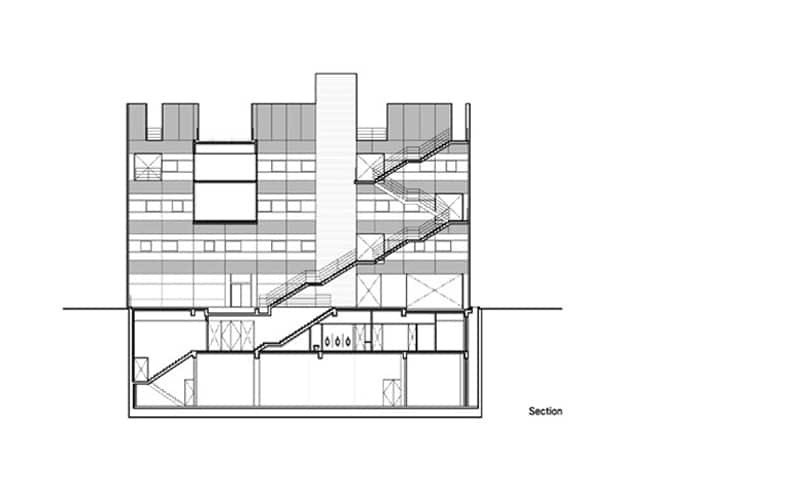Sinsa Building
| 완공년도 | 2005 |
| 위치 | 서울 신사동 |
| 대지면적 | 584.10㎡ |
| 건축면적 | 338.98 ㎡ |
| 연면적 | 1,949.10 ㎡ |
| Mechanical engineer | 세아엔지니어링 |
| Electrical engineer | 우림 전기 |
| Contractor | GEO HYUN CONSTRUCTION CO |
| Scale | B2, 4F |
| Lighting design | 뉴라이트 |
| 완공년도 | 2005 |
| 위치 | 서울 신사동 |
| 대지면적 | 584.10㎡ |
| 건축면적 | 338.98 ㎡ |
| 연면적 | 1,949.10 ㎡ |
| Mechanical engineer | 세아엔지니어링 |
| Electrical engineer | 우림 전기 |
| Contractor | GEO HYUN CONSTRUCTION CO |
| Scale | B2, 4F |
| Lighting design | 뉴라이트 |
도산공원 정문 바로 앞에 위치한 이 땅은 그 땅값이 강남에서도 가장 비싸다고 들었다. 따라서 지을 수 있는 한 가장 많은 용적을 가져야 하겠지만, 이곳은 주거지역과 공원시설 등의 관련법규의 제약으로 우선 땅값에 비해 작은 규모로 지을 수 밖에 없었다. 그러나 임대를 목적으로 하는 건물인데다 우선 높이에서 제한을 받아 주어진 용적을 채우기 위해 내부공간은 중립성과 효율성이 먼저 요구되므로 이런 경우 대개 단순한 직면체의 건물로 지어지게 마련이다. 서향에 면하는 건축이어서 서향 빛에 내부공간을 보호할 필요도 있거니와, 서쪽에서 받는 햇볕의 아름다움을 나타내는 벽면이 도산공원을 들어가는 길을 강조하기 위해서도 필요하였다. 따라서 법규가 허용하는 가장 큰 직육면체를 세운 후 서쪽벽체를 떼어내서 길의 경계에 세우고 그 사이공간을 이용하여 주 출입계단을 만든다. 그 사이공간은 도시의 길과 이 건축의 내부를 연결하는 매개가 되며 물론 테라스카페 같은 용도로 쓰여 길거리 풍경을 풍성하게 한다. 결국 이 건축은 길과 어떻게 만나느냐의 문제였다. 이 길은 오픈 된 계단을 통해 연결되어 옥상의 정원과 만난다. 옥상에는 작은 다실이 있어 마치 번잡한 도시풍경에서 은폐되게 하였다 이른 바 Urban Hermitage라고 불렀다. 벽은 현무암을 사용했다. 원래는 내후성강판으로 둘렀으나, 이 설계 당시 내후성강판 사용에서 몇 가지 문제점을 관찰하고 있었다. 녹이 스는 과정에서 날리는 녹분이 인접 주택가에 미칠 영향을 고려해서 재료를 제주 현무암으로 바꾸었다. 제주 현무암은 중국에서 수입하는 현무암과는 달리 그 표면의 표정이 대단히 변화무쌍하다. 서로 다른 공극과 색채, 이를 이용하여 나누기 패턴을 만들고 이를 정교히 부착하면 특별히 서향의 햇볕에 이들이 노출되는 풍경이 참 아름다울 것이라 상상했다. 더구나 속절없이 물성을 지우고 나타나는 인근 상업건축의 가벼운 풍경에 비해 의미 있는 존재감을 나타내 줄 것으로 믿었다. 그래서 이 건축의 요체는 이 독립된 벽체가 된다.
The site, which is located right in front of the Dosan Park, is said to be one of the most expensive lands in Gangnam. Therefore, it was meant to have maximum gross area, but due to the restrictions of park and residential area related laws, it had to be built on a rather smaller scale compared to the land price. It should have neutral and efficient plan since the building has its purpose of lease with height restriction, naturally and usually it gets built as a simple box form.
As the building is facing the west, it was necessary to protect the interior space from the light, and also was necessary to provide a beautiful wall along the road to the Dosan Park to contain the sun light from the west. Hence the design started from the biggest box as the building regulation would allow, and we left the west side wall along the road and inserted the main staircase in between. The staircase space became a medium that connects the interior architecture and the urban street while enriching the streetscape with its use as a terrace or cafes.
In the end, it was about how the architecture meets the street. The street gets connected to the rooftop garden via open staircase. The rooftop contains small tea room which we called ‘Urban Hermitage’ where it can be hidden from the bustling cityscape. The walls were finished with basalt. Initially we thought of using corten-steel, however there were concerns regarding rust dust possibly affecting residential area. Unlike basalt imported from China, Jeju basalt had a very varied surface expression. I imagined that numerous cut panels carefully laid and jointed would create some beautiful patterns when exposed to the west light. Moreover, it was believed that it would show a meaningful presence compared to the plastic scenery of neighboring commercial buildings that appear after reluctantly erasing material properties.
So, the essence of this architecture becomes this independent wall.









